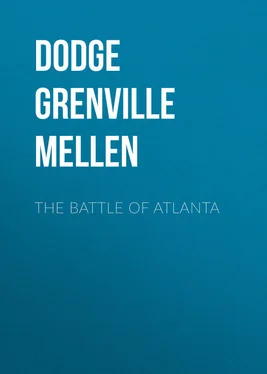Grenville Dodge - The Battle of Atlanta
Здесь есть возможность читать онлайн «Grenville Dodge - The Battle of Atlanta» — ознакомительный отрывок электронной книги совершенно бесплатно, а после прочтения отрывка купить полную версию. В некоторых случаях можно слушать аудио, скачать через торрент в формате fb2 и присутствует краткое содержание. Жанр: foreign_antique, foreign_prose, на английском языке. Описание произведения, (предисловие) а так же отзывы посетителей доступны на портале библиотеки ЛибКат.
- Название:The Battle of Atlanta
- Автор:
- Жанр:
- Год:неизвестен
- ISBN:нет данных
- Рейтинг книги:4 / 5. Голосов: 1
-
Избранное:Добавить в избранное
- Отзывы:
-
Ваша оценка:
- 80
- 1
- 2
- 3
- 4
- 5
The Battle of Atlanta: краткое содержание, описание и аннотация
Предлагаем к чтению аннотацию, описание, краткое содержание или предисловие (зависит от того, что написал сам автор книги «The Battle of Atlanta»). Если вы не нашли необходимую информацию о книге — напишите в комментариях, мы постараемся отыскать её.
The Battle of Atlanta — читать онлайн ознакомительный отрывок
Ниже представлен текст книги, разбитый по страницам. Система сохранения места последней прочитанной страницы, позволяет с удобством читать онлайн бесплатно книгу «The Battle of Atlanta», без необходимости каждый раз заново искать на чём Вы остановились. Поставьте закладку, и сможете в любой момент перейти на страницу, на которой закончили чтение.
Интервал:
Закладка:
As soon as General Curtis assumed command General Halleck commenced urging him to move to the south on Springfield, agreeing to send to him Colonel Jeff C. Davis's Division to join him before reaching Springfield, which Division was about 5,000 strong, and was with Pope on the Lamine River line. Curtis hesitated, and did not feel secure with the forces he had, although Halleck did not believe Price would stand for a fight, or that Curtis would need Jeff C. Davis's Division.
The Army of the Southwest, about seven thousand strong, was organized at Rolla, and moved from there January 14th, towards Springfield, halting at Lebanon. From Lebanon it moved on to Marshfield, where Colonel Jeff C. Davis, with his Division, joined it. Great preparations were made there for the attack upon Price, and we moved out of Marshfield prepared for battle, General Siegel commanding the First and Second Divisions, one under General Osterhaus and the other under General Asboth. General Jeff C. Davis, from General Pope's Army, commanded the Third Division, and Colonel Eugene A. Carr the Fourth Division, a Brigade of which I commanded.
When within about three miles of Springfield we received orders to attack that town the next morning, and moved at midnight. All the reports we received were that Price was in Springfield ready for battle. I had the extreme left, and put out my skirmishers soon after midnight, supposing, of course, that I was in front of the enemy, although I had seen nothing of them. In the darkness I lost track of the company of the Fourth Iowa, who were the skirmishers of my Brigade, and was greatly worried at the fact, but at daylight I met them on the road mounted upon horses and dressed in all kinds of costumes. The officer in command, who was an enterprising one, had started his skirmish-line, and, not meeting any enemy, had pushed right into Springfield, which he found evacuated except for a rear guard and a number of horses. They mounted the horses and rode back to us. All this time our extreme right, under Siegel, was using its artillery upon the town, not knowing that the enemy had gone.
General Curtis, in his order of battle, instructed Captain Sheridan to line up his transportation in the rear of the line of battle, so that it could be used as a defensive obstruction for the troops to fall back to, provided they met any check or were driven back. Captain Sheridan looked on this order as a very singular one, and says that he could, in his imagination, if anything happened our army, see his transportation flying over that rough country, knowing that his mule-drivers would be the first to run, most likely from a false report, not even waiting for an attack. While this order at the time caused no comment, it now, after our long experience, looks very ridiculous, though not more so than many others, we received at the beginning of the war.
It was not long before we were all on the march through and beyond Springfield, Price and his Army being in full retreat, with a force, so far as we could learn, of about ten thousand men. We followed him as rapidly as possible, he leaving a strong rear guard under Colonel Little to stop us at every stream. General Siegel had urged upon General Curtis a detour by his two Divisions to head off Price or stop him, so that he could attack him in front while we attacked his rear. Curtis had acceded to this. I had the advance following up Price, and endeavored to hold him, while Siegel moved by another road, expecting to catch him in flank or get ahead of him.
I remember that about noon of each day at some good defensive point, generally across a creek with a wide, open valley, Price would open out with his artillery and cavalry and act as though he intended to give battle. Our cavalry would fall back to give way to our infantry, and we would go into line, put out our skirmishers, and lose half a day, and as night came on Price would get out without our accomplishing anything. I remember distinctly that my Regiment would go into line, strip themselves, and throw down the chickens, potatoes, apples, and other eatables they had foraged and taken during the day, and as they would go forward the troops in our rear would come up and gobble what they had dropped. About the third time the Regiment went into line I noticed the boys had left nothing but their knapsacks, and were holding on to their chickens and provisions. One of the boys saw me looking at them, and thinking I was going to order them to drop what they had in their hands or on their backs, he appealed to me, saying, "Colonel, we have fed that damned Thirty-sixth Illinois Infantry every day and left ourselves without any supper. They put up this game that is going on to get our chickens. There ain't any Price on that side of the river, and they can't fool us any longer if they do you."
At Cane Creek, Flat Creek, Sugar Creek, etc., we had pretty sharp skirmishes. I soon discovered the plan of Price. It was to leave a strong rear-guard and make a great show while his trains and the rest of his Army were pushing to the South as fast as possible; so as soon as I saw him stop I went at him head-on with the cavalry and infantry, not even waiting to deploy more than a Regiment. Price's men would line the road and get one or two volleys at us and then slip off into the woods before we could deploy or return their fire. They did not get hurt much, but we did; but at the same time it broke up his game of holding us back, and we kept close on to his rear. For two or three days we were looking for Siegel to get in ahead and check Price, when to our astonishment a report came from our rear that he had turned his column in on our road some eight miles behind us, and there was a general howl from the force that had been pounding away at Price's rear.
Finally we pushed Price back to Fayetteville, Ark., where we landed during the month of February, and where we were halted by General Halleck's orders, who stated that he would relieve our front of the enemy by his movements with the rest of his forces through Southeast Missouri, down the Mississippi, and up the Tennessee.
While Price was laying at Springfield, in December, he communicated with the Confederate Government, and changed all his Missouri State force as far as practicable into Confederate troops. He also complained to the Government, and to General Polk, who commanded at Columbus, Ky., of the impossibility of obtaining the co-operation of the Confederate forces west of the Mississippi River. From the representations of Polk and Price, the Confederate Government organized all the country west of the Mississippi River into a department known as the Trans-Mississippi District, and placed it under the command of General Earl Van Dorn, who assumed command early in February, 1862. As soon as he assumed command General Van Dorn prepared to make an aggressive campaign, using all his forces in Arkansas and those under Price, estimating that they would reach 30,000 troops. His plan was to move his forces directly from Arkansas northward, west of Iron Mountain, by way of Salem, while Price moved from Springfield directly east and joined his column by way of Salem and Rolla, thence the combined column to move directly on St. Louis, Van Dorn calculating that he could strike and capture St. Louis before Halleck could concentrate his troops or obtain any knowledge of his movements that would enable him to defeat him before reaching St. Louis. Van Dorn expected to make this move in February, and his plans and the energy with which he executed them and concentrated his troops shows him to have been an officer of ability and great energy. General Halleck's prompt movement of General Curtis's army from Rolla southwest in January, thus driving Price out of Springfield, compelled Van Dorn to change his plans, and instead of moving towards St. Louis he moved his troops by Van Buren and the Boston Mountains, making a junction with Price's force in the Boston Mountains below Fayetteville, and while General Curtis's Army was laying at Cross Hollows, evidently in full security, thinking his campaign was over and expecting Price and Van Dorn to be drawn away from his front by the movement down the Mississippi. General Curtis was obliged to scatter his forces in that destitute country over a wide expanse so as to obtain food and forage. Van Dorn, without our having any knowledge of the fact, marched over the Boston Mountains, and it was March 3d before General Curtis was aware that Van Dorn was almost in his front and on his flank. The Union refugees flying before Van Dorn's movement gave us the first reliable notice of the new combination and the new movement. General Curtis immediately sent out orders, and, by marching all night, during heavy snows and severe cold weather, was able to concentrate most of his force on Sugar Creek, near Bentonville. General Siegel and his force did not move promptly, as ordered by Curtis, and was almost cut off before reaching Bentonville. He had to cut his way through a portion of Van Dorn's Cavalry, which he was able to do without much loss, and our line was formed on the north side of Sugar Creek, facing to the south, – a strong position, – expecting to receive Van Dorn's attack on the main telegraph road from Fayetteville to Springfield. We were on a plateau with a broad open valley in our front. In the rear of us was what was known as the Cross Timbers, a deep gorge. To the west of us was much open ground, over which was a road parallel to the main road, passing down what was known as Little Cross Timbers, and entering the Springfield and Fayetteville road about midway between Elkhorn Tavern and Cassville, some four miles in our rear.
Читать дальшеИнтервал:
Закладка:
Похожие книги на «The Battle of Atlanta»
Представляем Вашему вниманию похожие книги на «The Battle of Atlanta» списком для выбора. Мы отобрали схожую по названию и смыслу литературу в надежде предоставить читателям больше вариантов отыскать новые, интересные, ещё непрочитанные произведения.
Обсуждение, отзывы о книге «The Battle of Atlanta» и просто собственные мнения читателей. Оставьте ваши комментарии, напишите, что Вы думаете о произведении, его смысле или главных героях. Укажите что конкретно понравилось, а что нет, и почему Вы так считаете.












